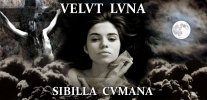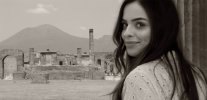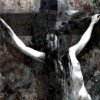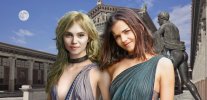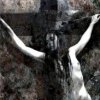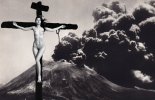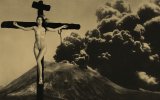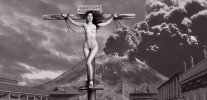'In the still air of the hot night, the moon seems the only thing alive, from the profiled edge of the mountains she seems to rise shining like a seabird that’s breaking from the shell in which she’s been hidden. Her faint light spreads across the plain, shadows that at first enwrapped the sleeping landscape in a veil of grey become black, objects take shape within the rays of the silvery moon.'
(From 'Amica, the Slavegirl of Pompeii' by Velut Luna.)
Velut Luna brought us some of the most exciting stories ever to have appeared on Cruxforums. She proved to be a remarkably talented writer, sharing her passions and fantasies in such an engaging way, that the reader feels privileged to experience her adventures, through the writing which now constitutes her legacy. That legacy remains undiminished by time.
Luna joined Cruxforums on 20 March 2014, having made a number of previous visits as a guest on the site. Two weeks later, she began her first major story, 'The Devil in the Convent.' This was concluded on 3 July 2014, and three days later, she started her 'Amica' story thread. 'Amica' was published over the course of the following year, being completed on 22 July 2015. Her third major story, 'Histoires de Luna' was started in May 2016, but remains unfinished since, sadly following a period of serious illness, Luna made her last visit to Cruxforums on 19 September 2016.
During the two and a half years that Velut Luna was with us, she presented four further threads of short stories and poems, 'Lyrics', 'Sibilla', 'Sybilla Oracle' and 'Stella', plus Eulalia's translation of Curzio Malaparte's 'Mermaid for Breakfast', in addition to the major works listed above. Whilst highly regarded as an accomplished author, Luna's charming personality ensured that she was a valued and well-loved member of Cruxforums. Her popularity as a contributor is currently endorsed by a remarkable post : likes ratio of 1 : 11.
The following links provide access to Luna's threads on Cruxforums. Additionally, 'The Devil in the Convent', 'Amica' and 'Histoires de Luna' are available in PDF form in the forum archive -
The Devil In The Convent
Mysteries of Naples The Devil in the Convent true story of Nuns of Sant' Arcangelo a Bajano a trial of the Inquisition in the sixteenth century Naples is the most mysterious city in Europe, and the only city of the ancient world that has not perished like Troy, or Nineveh, or...
www.cruxforums.com
Amica
AMICA The slavegirl of Pompeii Curses and Smoke Her name was Amica (loved girlfriend) and her name and footprint are embedded in a terra cotta tile alongside her girlfriend Detfri. The signed tile is a rare find, as Amica was a Roman slavegirl and not only her name, but a tangible imprint...
www.cruxforums.com
Histoires De Luna
Here only the incipit of a new story I'm thinking on, but I publish it at the end of my Amica story. Forbidden Games 'Look at that mess! Look at what a mess these photos! Where's your head! I've told you a thousand times that you have to watch where I tell you, not the air, in a vacuum...
www.cruxforums.com
Lyrics
DIANE The green graces undress In fairy forms exalt Wild fantasy From sparse reeds Diane appears In a gossamer dress of light In her mystic ice she blinds RED FIRE I appear at the door In a dress of red To tell that I am fire Raging and consuming A thorn has pricked me Of your red rose...
www.cruxforums.com
Sibilla
Sibyl I look beyond the gates of the night of your soul. The mist rising from the lake d 'Averno draw ghosts. Your fate is written on leaves that the wind confuses.
www.cruxforums.com
Sybilla Oracle
Sybilla Oracle You can ask to the Sibilla Cumana her Oracle for the future. Think a question (only in your mind don't write it) and after ask for: 1 Daily Oracle Once a day you can ask writing 'day' in your post or in a PM 2 Number Oracle Once a day you can ask writing a number from 100 to...
www.cruxforums.com
Stella
The events described actually happened two weeks ago. The characters belong to the real world. The names have been changed except my. Only the nightmare is a dramatization of probable facts. Stella This nightmare will never leave me, it keeps coming back like a ghost, haunting my spirit...
www.cruxforums.com
Do Mermaids Really Exist?
We all know that a mermaid is a sea creature with the head and torso of a woman and the tail of a fish. The question is, are mermaids real or just fiction? We humans have been fascinated by mermaids for a long time. A few hundred years ago, the myth of beautiful semi-human women living beneath...
www.cruxforums.com
I am indebted to Eulalia for her help and enthusiasm in collaborating on this thread, and I am delighted that the resulting retrospective celebration of Velut Luna is a joint effort by the two of us. Nobody was ever closer to Luna's stories during their development, since Eul was instrumental in the roles of consultant and editor, in addition to translating Luna's Italian texts. Their close friendship is celebrated in 'Amica', and Eul has often reiterated the sense of privilege felt by somebody who becomes so closely involved with another person's writing.
Last edited by a moderator:




